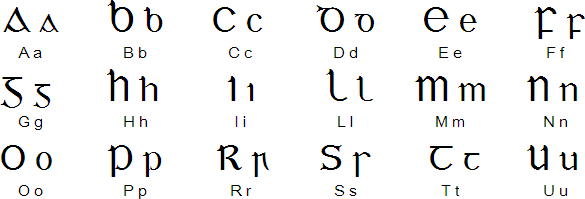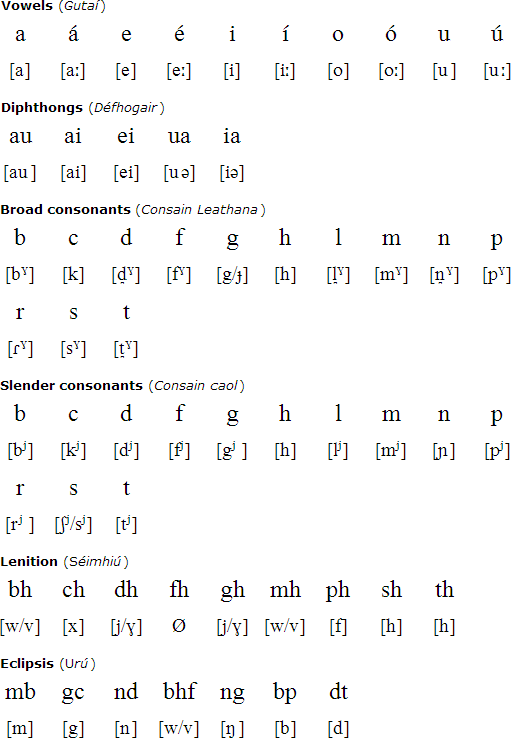An Irish Language Primer
Posted by ShamrockCraic on 28th Aug 2015
Irish (also commonly referred to as Gaelic in America) is a Celtic language spoken in mainly Ireland (Éire). There are also Irish speakers in the UK (Ríocht Aontaithe), the USA (Stáit Aontaithe Mheiriceá), Canada (Ceanada) and Australia (an Astráil). According to the 1996 census, 1.43 million people in Ireland claim to have some knowledge of Irish, 353,000 of whom speak it regularly. The main concentrations of Irish speakers are in the Gaeltachtaí, which are scattered mainly along the west coast of Ireland and have a total population of 82,715, 76.3% of whom speak Irish.
NAMES OF THE LANGUAGE
Irish is known as Irish, Gaelic or Irish Gaelic in English. The official standard name in Irish is Gaeilge /'geɪlɪk/. Before the 1948 spelling reform, this was spelled Gaedhilge. In Middle Irish the name was spelled Gaoidhealg, and it was Goídelc in Old Irish.
Other regional variations of the name in modern Irish dialects include Gaedhilic, Gaeilic, Gaeilig or Gaedhlag in Ulster and northern Connacht, and Gaedhealaing, Gaoluinn or Gaelainn in Munster.
RELATIONSHIP TO OTHER LANGUAGES
Irish is a member of the Goidelic branch of Celtic languages, also known as Q-Celtic. It is closely related to Manx (Gaelg/Gailck) and Scottish Gaelic (Gàidhlig), the other Goidelic languages. There is some degree of mutual intelligibility between them, particular between the Scottish Gaelic of Islay and Argyll, Ulster Irish, and Manx. The grammar and vocabulary of these languages are quite similar, but the spelling and pronunciation are different, especially Manx spelling.
Here is an illustration of some of the differences between Irish, Manx and Scottish Gaelic using the phrases 'How are you?':
- Irish (Standard) - Conas tá tú?
- Irish (Munster) - Conas taoi?, Conas tánn tú?, Conas tá tú?
- Irish (Connacht) - Cén chaoi a bhfuil tú?
- Irish (Ulster) - Cad é mar atá tú?
- Scottish Gaelic - Ciamar a tha thu? (informal) Ciamar a tha sibh? (formal)
- Scottish Gaelic (Lewis) - Dè mar a tha thu?
- Manx - Kys t'ou? (informal) Kanys ta shiu? (formal)
Irish is distantly related to Welsh (Cymraeg), Cornish (Kernewek) and Breton (Brezhoneg), which form the Brythonic branch of the Celtic languages, also known as P-Celtic. The Celtic languages all have a similar grammatical structure, but they have very little vocabulary in common.
DIALECTS
There are three main dialects of Irish: Munster (An Mhumhain), Connacht (Connachta) and Ulster (Ulaidh). The Munster dialect is spoken mainly in Kerry (Ciarraí) and Muskerry (Múscraí) in the western part of County Cork (Contae Chorcaí). The Connacht dialect is spoken mainly in Connemara (Conamara), the Aran Islands (Oileáin Árann) and Tourmakeady (Tuar Mhic Éadaigh) in County Mayo (Maigh Eo). The main area where the Ulster dialect is spoken is the Rosses (na Rosa). The dialect of Gweedore (Gaoth Dobhair) is essentially the same as the Ulster dialect.
THE OFFICIAL STANDARD (An Caghdeán Oifigiúil)
During the 1950s and 1960s a standardised form of Irish, known the An Caighdeán Oifigiúil (The Official Standard) was developed. It combines elements from the three major dialects and its pronunciation is based on the Connacht dialect. This is the form of the language taught in most schools.
DECLINE AND REVIVAL
Between the 17th and early 20th centuries, the Irish language was gradually replaced by English in most parts of Ireland. Famine and migration in the 19th and 20th centuries led to its further decline. However when the Republic of Ireland came into being in 1922, Irish was adopted as an official language, along with English, and the government and civil service become, in theory at least, officially bilingual. Irish terms were also adopted for the titles of public figures and organisations - Garda (Police), Taoiseach (Prime Minister), Dail (Parliament).
Recently the Irish language has experienced a revival with the foundation of new publications, a radio service, a television station and the growth of Irish-medium education. Irish is also increasingly being used on independent radio stations in Ireland.
ORIGIN OF WRITING IN IRELAND
Irish first began to appear in writing in the form of Ogham inscriptions during the 4th century AD. When St Patrick introduced Christianity to Ireland in the 5th century, Irish writers began to write in Latin, while at the same time, Irish literature written in the Latin alphabet began to appear. The Viking invasions of the 9th and 10th centuries led to the destruction of many early manuscripts, so most surviving manuscripts were written after that time.
GAELIC TYPE (Cló Gaelach)

The Irish uncial alphabet originated in medieval manuscripts as a variant of the Latin alphabet. It was used for printing Irish until quite recently and is still used on road signs and public notices throughout Ireland. Here is a sample text in the Irish uncial alphabet, from Article 1 of the Universal Declaration of Human Rights:

Transliterated into Roman type (cló Rómhánach), it reads: Saolaítear na daoine uile saor agus comhionann ina ndínit agus ina gcearta. Tá bua an réasúin agus an choinsiasa acu agus dlíd iad féin d'iompar de mheon bráthreachais i leith a chéile.
Translated, it means: All human beings are born free and equal in dignity and rights. They are endowed with reason and conscience and should act towards one another in a spirit of brotherhood.
THE MODERN IRISH ALPHABET (An Aibítir)
Today Irish is usually written with a version of the Latin alphabet similar to the one used for Scottish Gaelic, though a spelling reform in 1957 eliminated some of the silent letters which are still used in Scottish Gaelic.
| A a | B b | C c | D d | E e | F f | G g | H h | I i |
|---|---|---|---|---|---|---|---|---|
| á | bé | cé | dé | é | eif | gé | héis | |
| L l | M m | N n | O o | P p | R r | S s | T t | U u |
| eil | eim | ein | ó | pé | ear | eas |
The letters j (jé), k (ká), q (cú), v (vé), w (wae), x (ex), y (yé) and z (zae) do not occur in native Irish words, but do appear in some English loanwords, for example jab (job) and veain (van).
IRISH PRONUNCIATION CHART

NOTES ON PRONUNCIATION
Lenition. (séimhiú) is a change in sound that occurs to the beginning of words caused by a preceding word, such as a preposition. Lenition is indicated by adding an h after the initial consonant. For example, the Irish for shoe is bróg, [brok] but my shoe is mo bhróg[mÉ? vrok].
Eclipsis. (urú) happens after certain words, such as i, which means "in". Eclipsis in indicated by adding a extra consonant before the initial consonant. For example, the Irish for "in Paris" is i bParis [ɪ bariÊ?]. The important thing to remember about eclipsed consonants is that only the first consonant is pronounced.

